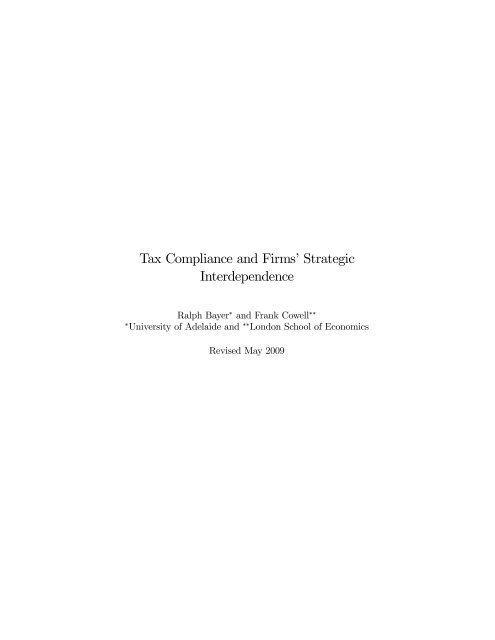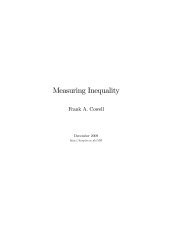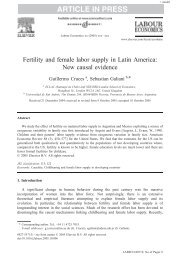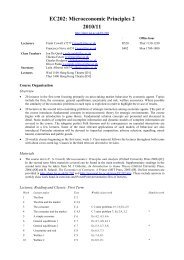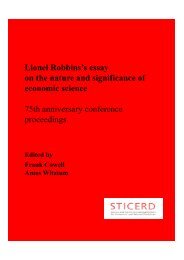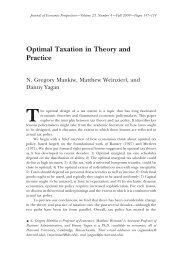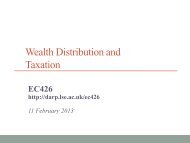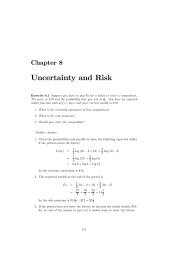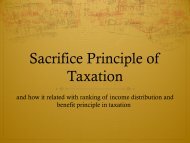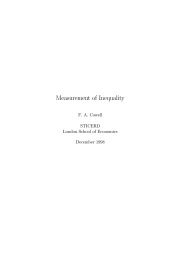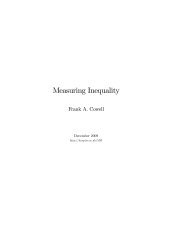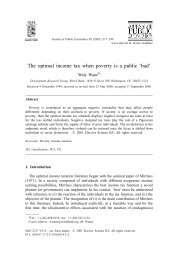Bayer, R.- C. and F. A. Cowell - DARP
Bayer, R.- C. and F. A. Cowell - DARP
Bayer, R.- C. and F. A. Cowell - DARP
You also want an ePaper? Increase the reach of your titles
YUMPU automatically turns print PDFs into web optimized ePapers that Google loves.
1 IntroductionThe behaviour of …rms is sometimes glossed over in the economic analysis oftax policy. In the analysis of tax compliance it is often omitted altogether.This omission is rather odd: tax inspectors typically use background knowledgeabout markets <strong>and</strong> industries in order to re…ne the monitoring <strong>and</strong>auditing process <strong>and</strong>, even if this knowledge is exercised in rule-of-thumbfashion, one would expect it to be in conformity with rational economic principles.Of course, …rms do make an appearance in the st<strong>and</strong>ard complianceliterature, but only in a rather specialised manner <strong>and</strong> in connection withrather specialised questions. In this paper we take a step toward a richeranalysis.What makes the tax-compliance problem di¤erent for …rms or corporationsin contrast to individual taxpayers? There are two main areas ofdi¤erence: (1) the nature of the internal organisation of corporations thatmay a¤ect important aspects of their external activity including tax reporting(Crocker <strong>and</strong> Slemrod 2005, Chen <strong>and</strong> Chu 2005), (2) the nature ofthe …rm’s external activities in the market. This paper concentrates on thesecond of these two areas <strong>and</strong> focuses on corporate tax-evasion <strong>and</strong> marketdecisions in an oligopolistic setting. We examine the impact of alternativeaudit rules on receipts from a tax on pro…ts, allowing for both complianceresponses <strong>and</strong> market responses by the …rms. Why does this alternativefocus make such a di¤erence to the analysis?Most models in the literature focus on a simple proportionate auditrule in an adapted version of the Allingham <strong>and</strong> S<strong>and</strong>mo (1972) model, asthough …rms habitually play the dual roles of producers <strong>and</strong> gamblers. 1 Inmany of the st<strong>and</strong>ard models of corporate compliance there is a fundamentalseparation result between the production <strong>and</strong> concealment activities. Thisconclusion appears to be robust to alternative assumptions about marketstructure <strong>and</strong> the speci…cations of …rms’objectives. However, taxes are notneutral in a setting where the behaviour of the tax authority depends on allthe declarations in a particular market. The tax authority can exploit thismarket-based information <strong>and</strong> so, in the light of this, we investigate the implicationsof using a more intelligent audit rule that is easily implementable.Speci…cally we focus on a relative audit rule –where the probability of auditof a particular …rm depends on that …rm’s observable behaviour relative toothers operating in the same market. 21 See Nur-tegin (2008) <strong>and</strong> Slemrod (2004) for recent overviews of the literature.2 This type of audit rule <strong>and</strong> the associated compliance behaviour has been examinedin the laboratory (Alm et al. 1993, Clark et al. 2004, Collins <strong>and</strong> Plumlee 1991). In order1
Our aim in this paper is to provide an economic rationale for relativeaudit rules that are used by some tax authorities <strong>and</strong> to explain why it is toa tax authority’s advantage to use a relative rule. We also demonstrate theadvantages of such a policy beyond the authority’s narrow tax-complianceobjectives: the idea is that introducing a relative audit rule would introducea regime where tax enforcement can in‡uence output decisions. Byconditioning an individual audit on the declaration of all …rms the authoritycreates an externality. The externality can be seen as generating twodividends: (a) less tax evasion <strong>and</strong> (b) an e¢ ciency improvement. The reductionin tax evasion is a direct result of the tax authority’s making betteruse of available information from all …rms taken together. The move towardstatic e¢ ciency arises because of an induced increase in output generatedby the switch in enforcement regime.The paper is organised as follows. Section 2 reviews the story of corporatetax compliance as conventionally presented in the literature <strong>and</strong> outlinesthe model presented here; section 3 examines the equilibrium behaviour of…rms in the two main dimensions of decision-making <strong>and</strong> sections 4 to 6present the main results, for both non-collusive <strong>and</strong> collusive behaviour. Finally,section 7 concludes. Proofs of propositions <strong>and</strong> lemmas are providedin the Appendix.2 The setting <strong>and</strong> model outline2.1 BackgroundThe literature on models of corporate tax compliance usually focuses onone of two relatively simple market structures – competitive price-takingor monopoly. The elements of such a model are as follows: a risk-neutralprice-taking …rm with constant marginal costs <strong>and</strong> a determinate dem<strong>and</strong>curve faces a proportionate pro…ts tax. The sole source of uncertainty iscreated by a combination of the …rm’s actions (the …rm can conceal pro…t,but at a cost) <strong>and</strong> the government’s tax audit (a given audit probabilitywith a known penalty proportionate to the amount concealed). The …rmconceals up to the point where the marginal cost of concealment equals themarginal reduction of expected tax rate, a rule that is independent of the…rm’s output level (<strong>Cowell</strong> 2004).to be e¤ective it is necessary that the tax-payer’s environment be one that permits observationby each agent of a signal related to the tax liability of others. In the laboratory thiscan be arti…cially arranged: within an industry this may occur naturally from specialisedknowledge of market conditions.2
allows substituting C 0 from (7) into (8). Applying (9) <strong>and</strong> using (4) gives asimpli…ed …rst-order condition for the optimal output choice:nXj6=i@ i (d (q)) @d j (q)[@d j @q i i ] + 1 t + @ i (d) @i (q)[i @d i i ] = 0:i @q i(10)The set of conditions (10), one for each …rm, characterises the equilibrium.Using this characterisation of equilibrium we can now present the mainresults in three steps: sections 4 to 6.4 Compliance decisionsIn this section we compare the di¤erent e¤ects that …xed <strong>and</strong> relative auditrules have on the extent of tax evasion. If the declaration stage has aninterior solution then, under weak conditions, a relative audit rule leads toless tax evasion than a comparable …xed audit rule. 12The intuition for the result appears simple: in addition to the typicalincentives provided by a …xed detection probability <strong>and</strong> the corresponding…ne, a relative audit rule provides a further incentive to increase the declaration,as this decreases the detection probability. If one replaces the relativeaudit rule in (5) with a …xed audit rule the …rst-order condition becomest 0 i [f + t] = C 0 i( i (q) d i ): (11)To compare the rules (7) <strong>and</strong> (11) we need a criterion that makes the two regimescomparable. Suppose we require the equilibrium detection probabilityin the relative-rule scenario to be equal to the …xed-detection probability.This ensures that the audit costs incurred by the authority are equal underboth regimes. Setting i (d 0 ) = 0 i <strong>and</strong> keeping the pro…ts the same in bothcases it is clear that (7) <strong>and</strong> (11) di¤er only by the “shading”term@ i (d)@d i[ i i ]:This is just the additional incentive to increase the declaration in order toreduce the detection probability <strong>and</strong> leads to higher declarations under arelative audit rule.However, this intuitive argument neglects the dependence of …rm’s decisionupon the decisions of the others under a relative audit rule. More is12 The result is also valid if …rms compete in prices rather than quantities.11
equired for a clear-cut result. We use a well known result on supermodularityto show the following – proofs of this <strong>and</strong> of other results are to befound in the Appendix.Lemma 1 Denote the vector of interior equilibrium declarations that prevailsunder an arbitrary …xed rule ( 0 1; 0 2; :::; 0 n) as d 0 := (d 0 1 ; d0 2 ; :::; d0 n).Then for a relative rule i (d) that induces a supermodular declaration game<strong>and</strong> satis…es i (d 0 ) = 0 i 8i 2 Nan equilibrium exists withd i > d 0 i 8i 2 N:The supermodularity condition used in Lemma 1 is su¢ cient but notnecessary for the result that an equilibrium with lower evasion exists undera relative rule. It ensures that all best responses are globally increasing inthe declarations of the other …rms <strong>and</strong> embodies the basic intuition of howa relative rule works. A relative rule designed to induce a …rm to react witha higher declaration if another …rm increases its declaration thereby createsan externality that is bene…cial from the tax authority’s point of view: forgiven levels of gross pro…ts there will be higher declarations than under a…xed rule.There are many audit rules that satisfy the supermodularity condition;for example a simple rule that is linear <strong>and</strong> additively separable in thedeclarations – see Proposition 1 below. By contrast, consider what wouldbe necessary for the condition not to hold: then there must be a positivecross-derivative of the detection probability that is large compared to thechange of the probability in the declaration of the opponent. Under suchcircumstances the direct externality – the in‡uence of the declaration of acompetitor on the detection probability – is overcompensated by the rulespeci…ce¤ect that an increased declaration of the other …rm reduces thereactivity of the detection probability with respect to the own declaration.A rule which does not preserve supermodularity would have to be such thatan increased declaration of a competitor reduced the marginal impact ofa …rm’s own declaration considerably. Such rules are not realistic, as thiswould mean that the authority puts more weight on the declarations of thecompetitors than on that of the …rm in question when deciding on the auditintensity. However, even if the supermodularity condition is violated, theresulting equilibrium under a relative rule can still lead to less evasion. It12
is important to note that all the results on e¢ ciency derived later in thispaper do not depend on supermodularity.The proposition below deals with two concerns: (a) the set of rules satisfyingthe supermodularity condition might be empty <strong>and</strong> (b) there mightbe multiple equilibria, of which some lead to higher evasion than the …xedrule. The proposition below shows that there exists a very simple rule whichrules out both of these concerns.Proposition 1 For given gross pro…ts <strong>and</strong> any …xed rule with detectionprobabilities 0 i leading to interior declarations d 0 there exists a simplerelative rule i (d) with P ni=1 0 i = P ni=1 i(d) 8d that induces a uniqueequilibrium vector d with d i > d0 i 8i 2 N:So, in a situation where there is competition among the few, switchingto a more intelligent audit rule yields an immediate dividend –less evasion.Proposition 1 makes sure that such a rule exists for all initial conditions <strong>and</strong>that the authority does not need any additional information. The declarationsunder the old …xed rule are su¢ cient. Basically, any linear relativerule that assigns the same detection probability to the …rms given their initialdeclarations <strong>and</strong> satis…es the supermodularity condition will do. Againsupermodularity is su¢ cient.5 Output decisionsThere is more to be said on behalf of the relative audit rule. As we noted(section 2.1), in simple competitive <strong>and</strong> noncompetitive models the taxenforcementparameters do not distort output, although this result dependson the way in which the audit probability <strong>and</strong> penalty rate are formulated(Lee 1998). So too in our model: there is no e¤ect on output if auditprobabilities are independent of declarations. However, this is not true foroligopoly: here a switch to relative auditing will result in e¢ ciency gains.For this purpose we assume that the underlying market conditions <strong>and</strong>cost structure ensure that a Cournot game will have a unique <strong>and</strong> stablepure-strategy Nash equilibrium: we will refer to this as a regular Cournotoligopoly. 13 We assume that the game has a compact strategy space, where13 Su¢ cient conditions for a regular Cournot oligopoly are set out in Vives (1999),chapter 4 <strong>and</strong> are derived from Novshek (1985). Oligopolies with multiple equilibriaare excluded in order to have a de…nite reference for the comparative-statics analysis; butwe do not exclude games where the resulting Cournot game with relative auditing hasmultiple equilibria as long as the underlying Cournot game has a unique equilibrium inpure strategies.13
the inverse dem<strong>and</strong> function p () is decreasing <strong>and</strong> log-concave <strong>and</strong> where,for every …rm i, production costs K i () are such that 14K 00i (q i )p 0 (Q) > 0, Q := X ni=1 q i: (12)These conditions are relatively mild <strong>and</strong> allow for oligopolies typically usedin applied work (for example models with linear dem<strong>and</strong> <strong>and</strong> cost). Theyare su¢ cient to establish the following result that guarantees uniqueness <strong>and</strong>stability of the equilibrium of the oligopoly game in the absence of relativeauditing.Lemma 2 In regular oligopolies the best-response functions of …rms havenon-positive slopes greater than 1:To examine the e¤ects of audit rules on output we …rst establish that thebest-response quantity of an individual …rm under relative auditing is largerthan under a …xed audit rule. As mentioned above under a …xed audit rulethe quantity decision is equivalent to the decision in an oligopoly withouttaxation <strong>and</strong> tax enforcement.Proposition 2 Under an independent audit rule output is independent ofthe evasion decision <strong>and</strong> equals the Cournot quantities. 15Now consider relative auditing. Denote the best response of …rm i in theregular Cournot game as BR C i (q i), while BR R i (q i) gives the best-responsecorrespondence under a relative audit rule.Lemma 3 Assume that the market organisation has the form of a regularCournot oligopoly. If q i implies BR C i (q i) > 0 then BR R i (q i) >BR C i (q i).This result might seem surprising. After all, what does a …rm gain fromextending its output beyond the Cournot best-response level? By increasingoutput in this way it would seem that a …rm reduces its own gross pro…t <strong>and</strong>the gross pro…ts of the competitors – a loss rather than a gain. However,recall the role of the informational externality here. As q i increases thepro…ts of other …rms fall, so the optimal declarations of the other …rms fall.Therefore the probability of audit of …rm i decreases, which in turn gives …rm14 Again primes denote derivatives. These conditions are su¢ cient for Cournot gamesto have a unique Nash equilibrium in pure strategies (Vives 1999, Theorems 2.7 <strong>and</strong> 2.8).15 Cf Marrelli <strong>and</strong> Martina (1988), page 58.14
i more scope for evasion. By increasing output beyond the Cournot quantitya …rm intends to trade some gross pro…t for a better environment for evasion.This externality can be characterised by the di¤erences in the …rst-orderconditions for the quantity choices under the di¤erent rules. Comparing the…rst-order conditions shows that the externality under relative auditing isgiven by the termnX @ i (d ) @d j[@d j @q i i ] ;ij6=iwhich describes the in‡uence of …rm i’s quantity on i’s expected payo¤by the indirect e¤ect on the other …rms’ declarations <strong>and</strong> hence …rm i’saudit probability. As the other …rms will decrease their declaration if theirpro…t is decreased, which decreases …rm i’s audit probability, …rm i has anincentive to sabotage the other …rms’pro…ts by producing more than underthe equilibrium of the underlying Cournot oligopoly.The result from Lemma 3 is su¢ cient to ensure that the aggregate quantityunder a relative auditing rule is larger if (a) the oligopoly is regular <strong>and</strong>symmetric <strong>and</strong> (b) the equilibrium under relative auditing is also symmetric.However, we can use the properties of a regular oligopoly to generalise it:Proposition 3 If the underlying Cournot oligopoly is regular then any interiorequilibrium outcome under a relative audit rule yields higher aggregateequilibrium quantity than under a …xed rule.The intuition is illustrated for a duopoly in Figure 1. The solid straightlines represent the best-response functions of …rms 1 <strong>and</strong> 2 in a Cournotduopoly: so the intersection shows the equilibrium quantities q C := q1 C; qC 2in the case where a relative audit rule is not employed. The best-responsequantities for a given quantity of the competitor are greater under a relativethan under a …xed rule (Lemma 3). Therefore in the case of the relativeaudit rule the best-response function for …rm 1 must lie to the right of …rm1’s Cournot response function <strong>and</strong> that for …rm 2 must lie above …rm 2’sCournot response function. Essentially the same reasoning holds if the …rm’sbest response is characterised by a multivalued correspondence. Without theneed to specify the reaction functions in detail it is clear that an equilibriummust lie in the shaded area of Figure 1: the broken lines illustrate thereaction functions for one such case. Given that iso-quantity contours arelines with slope 1 the equilibrium must lie on a higher contour than theone passing through q C : total output under the relative audit rule must begreater than under a …xed rule.15
q 2q 1BR 1R (q 2 )q Rq C2q C.BR 2R (q 1 )q C1Figure 1: Quantity competition: equilibrium under alternative auditing regimesIn other words, increasing individual output reduces the impact of theexternality resulting from the relative audit rule. A lower gross pro…t helpsto close the gap in the net pro…ts between the situation with an audit ()<strong>and</strong> the situation without (). Since all …rms have the same incentives thisdoes not really work: they all try to reduce the impact of the externalities byincreasing quantity, so they are all worse o¤ than if they had just producedthe Cournot quantity at the …rst stage. The externalities imposed by theauthority on the pro…t declaration spill over into the output-decision stage.6 CollusionDoes the relative audit rule still produce desirable results if …rms do notbehave competitively? We analyse this using three scenarios based on the16
two-stage nature of …rms’decisions. First (section 6.1), one might think of asituation where …rms are able to cooperate when they …le their tax returns;the repeated nature of preparing tax returns might allow for tacit collusionby using simple trigger strategies, <strong>and</strong> tax benchmarking 16 might be usedas a monitoring device to detect cheating. Second (section 6.2), …rms maybe able to collude at the production stage in the classic fashion. Finally(section 6.3) we consider the case of …rms colluding on both declarations<strong>and</strong> production quantities.In all three scenarios we only consider …rms implementing strategy pro-…les that maximise joint pro…t. This can be seen as the most conservativetest for the usefulness of a relative rule, as this assumption gives …rms thebest chance of jointly eliminating the externality imposed among them bya relative rule. Moreover perfect collusion might be a rare event for tworeasons. First, the conditions necessary for full collusion to be sustainedmight not be satis…ed in a particular industry. For collusion to be sustainableamong other things the detection of cheating needs to be possible (orat least actual cheating must incease the believed probability that cheatinghas taken place) <strong>and</strong> …rms must be su¢ ciently patient. 17 Secondly, it it isnot clear that …rms actually collude perfectly even if collusion is sustainableas an equilibrium, as there are also many other, more competitive equilibria(including some implementing the competitive stage-game Nash equilibriumanalysed above).6.1 Collusion: Declaration stageOne concern with a relative rule is that …rms might collude when …lingtheir tax returns in order to overcome the externality imposed by the rule.Collusion in a one-shot game can only be an equilibrium if binding contractson declarations can be written. This is not the case for tax returns in thereal world. A more compelling rationale for potential collusion lies in therepeated nature of the process of declaring pro…ts. For collusion at thedeclaration stage in the repeated-game context it is necessary that …rmsobserve a signal of the previous declarations of other …rms. This may even16 Tax benchmarking can be carried out by independent observers from publicly availableinformation. It “allows corporations to identify how much they are paying compared toother companies in the industry. It may highlight a high tax rate which could be due tolack of e¢ cient control <strong>and</strong> management of the tax function. Conversely, it could highlighta low tax rate compared to the peer group which could be due to a tax strategy which, ifsuccessfully challenged, could harm the company’s reputation....” (Burak et al. 2007)17 See Mailath <strong>and</strong> Samuelson (2006) for details of what is implementable as an equilibriumdepending on the informational structure.17
e facilitated by o¢ cial policy if the tax agency requires public disclosureof information such as use of tax shelters <strong>and</strong> book-tax di¤erences in anattempt at “moral suasion” on corporations. Slemrod (2004) has arguedthat poor implementation of this policy may actually lead to a “race tothe bottom” (p. 895) –i.e. e¤ective collusive behaviour amongst supposedcompetitors. 18Let us analyse this part of the problem by assuming that …rms are able tosustain perfect collusion at the declaration stage, while Cournot competitiontakes place at the production stage. The important question here is whethercolluding …rms are able to turn the relative rule to their advantage <strong>and</strong>achieve better results than under a …xed rule. Does a relative rule performworse or better than a …xed rule if …rms collude at the declaration stage?Under a relative rule without collusion the equilibrium outcome at thedeclaration stage is a vector d (), giving optimal declarations as a functionof all …rms’gross pro…ts. These equilibrium declarations implement avector of expected net pro…ts (E 1 (d ; q); :::; E n (d ; q)). Now assume thatunder collusion all the declaration vectors d that at least weakly increaseall individual payo¤s are feasible. Denote the set of all declaration vectorsthat are feasible asD = fd 2R n + : E i (d; q) E i (d ; q)g:Consider the case where …rms are able to sustain perfect collusion by maximisingjoint pro…t. A collusion agreement is characterised by a vectord co 2 D co wherenXD co = arg max E i (d; q) : (13)d2DNote that the minimum payo¤ condition can always be satis…ed if sidepayments are allowed. The …rst-order condition for an interior maximumfor …rm i is@ P n@d i j=1 E j(d) = 0, which can be written asnXj=1@ j (d) @ij j +i (d)@d i @d iThis gives us:i=1@ i+ @ i+C@d i @di( 0 i (q) d i ) = 0: (14)i18 Greater transparency in reporting could have other e¤ects such as …ne-tuning of “evasionincentives”to corporate tax managers (Slemrod 2004, page 886) <strong>and</strong> enhancing politicalpressure for good tax policy (Lenter et al. 2003). These topics go beyond the scopeof the present paper.18
Lemma 4 Any jointly optimal declaration vector satis…esn t (d) [f + t] nX= Cj( 0 j d j ); (15)j=1where (d) is the average audit probability (d) := 1 nnX j (d) : (16)Applying Lemma 4 in a symmetric environment where the gross pro…tsof all …rms are equal <strong>and</strong> the relative audit rule is symmetric shows thatunder these conditions the relative audit rule leads to the same declarationas a uniform …xed audit rule if …rms collude on declaration.Proposition 4 Let d ij denote the declarations of all …rms other than i<strong>and</strong> j. If i = 8i <strong>and</strong> d i = d j =) i (d i ; d j ; d ij ) = j (d i ; d j ; d ij ) 8i 6=j; d ij then the symmetric pro…le of jointly optimal declarations coincideswith d x , the declarations resulting from a uniform …xed audit rule.Proposition 4 gives a guideline of how a relative rule compares in termsof tax revenue to a …xed rule if …rms collude at the declaration stage. Whencooperating on tax returns …rms eliminate the externalities imposed by arelative rule. In this case the relative rule <strong>and</strong> the …xed rule lead to thesame outcome if the gross-pro…t situation is symmetrical.Some of the intuition underlying this result also applies to asymmetricindustries, where gross pro…ts di¤er across …rms: by Lemma 4 colluding…rms will always internalise the externalities created by the relative rule.But in the asymmetric case …rms can do more because they can exploit therelative rule to save some evasion costs. It is jointly optimal to distort thedeclaration of …rms with higher pro…ts somewhat upwards, while distortingthe declarations of low-pro…t …rms somewhat downwards, compared to theindividually optimal declaration under a …xed rule. This e¤ect is driven bythe increasing marginal evasion cost; so the shape of the evasion-cost curveis the principal factor determining whether collusion leads to higher or loweraggregate declarations. However, the precise result depends on the shape ofthe relative audit rule. The role of evasion costs is most clearly seen in thecase of a linear-symmetric rule – the simplest rule satisfying assumptions(D1)-(D4). In this casej=1@ i (d)@d i= @ j (d)@d j= c 8d; i 6= j (D5)19
<strong>and</strong> the following result is available:Proposition 5 For any d co 2 D co a linear-symmetric evasion rule satisfying(D5) implieswhere d coinXi=1nXi=1d xid xinXi=1nXi=1d coi if C 000i ( i d i ) 0 8d i 2 [0; i ] ; (17)d coi if C 000i ( i d i ) 0 8d i 2 [0; i ] ; (18)st<strong>and</strong>s for the declaration of …rm i under collusion.In the case of the simple relative rule (D5), if marginal evasion costsincrease at an increasing rate then joint expected net pro…t maximisationleads to a higher aggregate declarations than under a …xed rule.How is production in‡uenced by a relative rule if collusive declarationsare possible? The declaration vector that maximises joint pro…ts at thesecond stage depends on the vector of gross pro…ts resulting from the productionstage. In the non-collusive setting (Section 5) we know that thereis an incentive to produce more than the Cournot quantity in order to increasethe evasion opportunity: the main channel for this is the fact thatincreasing your quantity reduces the pro…t <strong>and</strong> declarations of your rivals,which in turn reduces your own detection probability. The following lemmacon…rms this e¤ect under cooperative declaration behaviour:Lemma 5 Increasing the own quantity under cooperative declaration decreasesthe equilibrium declarations of the competitors at the collusive declarationstage:@d coj@q i< 0 8j 6= i:So there is still an incentive to increase production beyond the Cournotquantity in order to reduce competitors’ pro…ts, with the intention of decreasingone’s own equilibrium detection probability. Then the absence ofother e¤ects (such as cooperative saving of evasion cost in the asymmetriccase) is a su¢ cient condition for a relative rule to increase output <strong>and</strong> henceto yield e¢ ciency gains. A su¢ cient condition is symmetry.Proposition 6 If identical …rms collude at the declaration stage under asymmetric relative rule then the aggregate production quantity exceeds thequantity under a …xed rule with the same equilibrium detection probabilities.20
The incentive to sabotage the gross pro…t of competitors by choosing aquantity higher than the Cournot quantity is still present even when collusiontakes place at the declaration stage. Symmetry is su¢ cient –but notnecessary – for this e¤ect to translate into e¢ ciency gains. In a symmetricindustry where ex-ante identical …rms collude on declarations, a relativerule leads to the same declaration behaviour as a …xed rule while the secondbene…t of a relative rule, which is greater allocative e¢ ciency, still obtains.6.2 Collusion: Production stageNow focus on the question whether the relative rule (at the second stage) hasany impact on the cartel quotas chosen at the …rst stage. Does the relativerule fare better than the …xed rule with respect to economic e¢ ciency?Suppose …rms can jointly maximise expected pro…ts by choosing quantities,anticipating individually optimal choices at the declaration stage; butsuppose they cannot cooperate at the declaration stage. Then under a relativerule …rm i will declare d i as de…ned by the condition (7) dependingon the vector of gross pro…ts realised at the production stage; under a …xedrule the relevant condition is (11). If …rms can collude on production onlythen they will choose a jointly optimal vector of quantities given the anticipateddeclarations. For simplicity consider identical …rms <strong>and</strong> concentrateon a symmetric equilibrium. An equilibrium with a production vector requiringidentical quantities for all …rms implicitly assumes that the cartelof identical …rms restricts all feasible allocations to the ones where …rmsproduce identical quotas. 19First consider the case of a …xed audit rule. Denote the gross pro…tper …rm by (so that the aggregate gross pro…t is n) <strong>and</strong> the resultingaverage declaration by d. The expected joint net pro…t for equal quotas <strong>and</strong>19 In some cases …rms might be able to increase the expected joint net pro…t by using anasymmetric allocation of quotas. But there are good reasons why …rms in a cartel wouldrefuse to produce less than other …rms. If identical …rms bargaining over the collusionsurplus have equal bargaining power they should end up with the same surplus. Anallocation that implements di¤erent quotas can only be sustained if side payments arepossible. In the more likely case that side payments are not possible due to the oversightof a control agency then the best …rms can do is to choose the best cartel agreement where…rms have identical quotas. Even if side payments are possible …rms still might refuse toproduce less than other identical …rms, as they do not want to lose market share.21
consecutive optimal individual declaration becomes:nXE i = 1 0 n td + 0 n (1 t f) + fd nC i d ;i=1(19)where 0 is the …xed audit probability. Maximising this joint pro…t withrespect to symmetrical quotas (taking into account the declaration behaviourat the declaration stage) leads to the expected result. Firms choosethe quotas that maximise joint gross pro…t.Proposition 7 Under a …xed rule collusion at the production stage leads tomonopoly output if …rms consider only symmetric cartel agreements.We now turn to collusion at the …rst stage under a relative rule. Weagain restrict our analysis to ex-ante identical …rms, which are restricted tosymmetric cartel agreements. At the second stage …rms will independentlydeclare their pro…ts for a given vector of production quotas they agreed upon.The declarations are determined by the …rst-order conditions (5). At theproduction stage …rms agree on the set of symmetric quotas that maximizethe expected joint net pro…t given the anticipated declaration behaviour.Recall that property (D3) of the relative rule implies that the sum of theindividual audit probabilities is constant. Substituting (d ), the averageaudit probability, (see equation 16) into the expected joint pro…t givesnXE i = n td (d ) n td i=1+ (d ) n (1 t f) + fd nC i d : (20)Comparing the expression above to the expression for the case with a …xedrule shows that they are qualitatively equivalent. The di¤erence is that 0is now replaced by (d ). Not surprisingly, joint pro…t maximisation leadsto the monopoly output under a relative rule too.Proposition 8 Under a relative rule collusion at the …rst stage leads to themonopoly output if …rms only consider symmetric cartel agreements.Our analysis above shows that the relative audit rule loses its bite withrespect to the second dividend when …rms are able to form a cartel at theproduction stage. The relative rule does not prevent the …rms from restrictingthe aggregate output to the monopoly quantity. With respect to22
allocative e¢ ciency the relative rule does not fare worse than the …xed rule,though, as also under a …xed rule only the monopoly quantity is produced.It is noteworthy that the …rst dividend of a relative audit rule is not a¤ectedby the cartel at the production stage. Tax declarations are still higher underthe relative rule than under the …xed rule.6.3 Collusion: Both stagesHere we will brie‡y comment on the case where …rms are able to colludeperfectly on both the production <strong>and</strong> the declaration stage. We can drawon the results derived in the previous two sections.Let us start with the declaration stage, where a vector of gross pro…tswill have emerged from the collusive production stage. At that point theproblem of the …rms colluding at both stages is identical to that of …rmsonly cooperating at the declaration stage, with the di¤erence that now thegross pro…ts were determined by the collusive vector of declarations. Thejointly optimal declarations are now determined byD co = arg maxd2DnXE i (d; q co ) : (21)i=1This maximisation problem only di¤ers from the one considered above by apredetermined variable. So all the results on the performance of the auditrule from above (Lemma 4 <strong>and</strong> Propositions 4 <strong>and</strong> 5) still go through. Asexpected, …rms that are able to sustain collusion at both stages eliminatethe negative externality at the declaration stage, which leads to the samedeclarations as the corresponding …xed rule if the gross pro…ts from thecollusive production stage are symmetric. In the asymmetric pro…t situationthe performance of the relative rule depends (as above) on both the speci…cformulation of the rule <strong>and</strong> some properties of the concealment technology.Under a linear-symmetric rule the curvature of the marginal concealmentcost determines whether the joint saving of cost leads to higher or lowerdeclarations than under a …xed rule.We now turn to the production stage. There we have seen that restrictingattention to the symmetric case yields the result that …rms eliminate theproduction externality imposed by the relative rule if they collude only atthe production stage. This is also the case if identical …rms can collude atboth stages. The ex-ante expected joint pro…t in this case follows equation(20), with the slight di¤erence that the anticipated declaration vector isnow jointly optimal instead of being the result of a Nash equilibrium in the23
continuation subgames:nXE i = n td (d co ) n td i=1+ (d co ) n (1 t f) + fd nC i d : (22)From Proposition 4 we know that collusion at the declaration stage leads tothe same declarations as under a …xed rate. This means that it is straightforwardto show that the aggregate production of the cartel is the monopolyquantity: the proof is identical to the one proving Proposition 7.6.4 Collusion: SummaryCollusion at the declaration stage leads to …rms eliminating the externalityimposed by the relative rule at the declaration stage if they collude. Theresulting aggregate pro…t declaration is the same as under a …xed rule if…rms are identical. But if …rms di¤er with respect to their gross pro…ts thenthe outcome (in terms of the total pro…t declared) depends on the evasioncoststructure. If marginal evasion cost increase su¢ ciently strongly withthe tax evaded then …rms will declare more under the relative rule thanunder a …xed rule. The e¤ect that a relative rule has in terms of e¢ ciencygains (by increasing the quantities produced) still remains. The relative rulestill does better than the …xed ruleIf there is collusion at the production stage the relative rule’s positivee¤ect on allocative e¢ ciency vanishes. Under either audit rule …rms willjointly produce the monopoly quantity. However, the relative rule’s positivee¤ect on the pro…t declaration remains. Collusion at the productionstage does not spill over into the declaration stage. Firms are not able toeliminate the externality imposed on them if they can only collude at theproduction stage. If …rms can collude at both stages then both dividendsof a relative rule vanish, as then …rms completely internalise the externalitycreated by a relative rule. In a symmetric environment the collusive …rmsgenerate outcomes that are just the same as under a …xed rule. In asymmetricenvironments, as in the case of collusion at the declaration stageonly, the performance of the relative rule with respect to revenue collection(compared to a …xed rule) depends on the evasion technology.24
A.2 Proposition 1Proof. If the relative rule induces a supermodular declaration game then, byLemma 1, such an equilibrium exists. By construction the sum of detectionprobabilities is equal under the …xed rule <strong>and</strong> the relative rule for all dif 0 i = i (d 0 ) <strong>and</strong> if the rule satis…es condition (D3). Now consider anadditive separable rule, linear in the declarations:nX nX i (d) :=a i + b j d j ; b j = 0; b i < 0; b j6=i > 0: (27)j=1j=1By construction rule (27) satis…es conditions (D1)-(D4) <strong>and</strong> induces a supermodulargame, since condition (24) requires b j6=i 0.Su¢ cient conditions for a unique equilibrium are a compact strategy space,continuous payo¤s, which are quasi-concave in the own action <strong>and</strong> a bestresponsemap which is a contraction (Vives 1999 p. 47). The strategy spaceis compact, payo¤s are continuous <strong>and</strong>, by (D4), concave in own actions.For the best-response map to be a contraction we require@ 2 E i (d; q)@d 2 i+nXj6=iUnder rule (27) the condition becomes@ 2 E i (d; q)@d i @d j < 0 8i 2 N:2b i [f + t] C 00i ( d i ) + [f + t]which, because rule (27) requires P nj6=i b j =nXb j < 0;j6=ib i , impliesb i [f + t] C 00i ( d i ) < 0; (28)Condition (28) must hold, since b i < 0 <strong>and</strong> C 00i ( d i) > 0.A.3 Lemma 2Proof. We have to prove that dqi =dQ i 2 ( 1; 0] where Q i denotes theoutput of all …rms other than i. First, observe that the slope of the bestresponseis given by:dq idQ i==@ 2 i (q)= @2 i (q)@q i @Q i @qi2 =p 0 + p 00 q i2p 0 + p 00 q i K 00i(29)p 0 + p 00 q ip 0 + p 00 q i (K 00ip 0 ) : (30)29
where Q i denotes the output of all …rms other than i. As we have K 00i p 0 >0 by (12)dq i =dQ i 2 ( 1; 0] i¤ p 0 + p 00 q i 0:In what follows we prove by contradiction that p 0 + p 00 q i 0:Log-concavity of the inverse dem<strong>and</strong> function requires that:which is equivalent toNow suppose thatd 2 ln [p(Q)]dQ 2 0;From the …rst-order condition we know thatp 00 p p 02 0 (31)p 0 + p 00 q i > 0: (32)q i = (p K0 i )p 0 :holds along the best-response function. Substituting q i in (32) <strong>and</strong> multiplyingby p 0 ; which is positive, yields:p 00 (p K 0 i) p 02 > 0;comparing this with the condition for log-concavity from (31) leads to acontradiction, as Ki 0 is positive.A.4 Proposition 2Proof. The …rst-order condition (FOC) for optimal output under independentaudit is similar to the corresponding condition under a relative audit rulebut does not contain any indirect in‡uences via changes in the competitors’declarations due to a changed output. Setting @ i (d) =@q i = 0 in (10) givesthe condition 1 t + @ i (d) @i (q)[@d i i ] = 0; (33)i @q iwhich only holds if @ i (q) =@q i = 0: This implies that the oligopolists choosethe Cournot quantity.30
A.5 Lemma 3Proof. From condition (10) for optimal quantities we have:@ i (q)@q i=P nj6=i@d j (q) @ i (d (q))[@q i @d i i ]j1 t + @ : (34)i (d)[@d i i ]iGiven that t < 1, i < i <strong>and</strong> @ i (d ) =@d j is positive (negative) if i 6= j(i = j), the sign of @ i (q) =@q i has the same sign as @d j (q) =@q i –all competitorshave qualitatively identical …rst-order e¤ects. Firm j’s declarationis in‡uenced by a change of q i through the change in its own pro…t <strong>and</strong> thereactions of other …rms due to their changed pro…ts. Di¤erentiating (7) <strong>and</strong>using (6), …rm j’s subgame-perfect reaction to …rm i changing its quantitycan be written as:@d j@ j@ j (q)@q i= 1 Cj 00 [f + t] @ j (d ) @j (q)(35)@d j @q iwhere = @ 2 E j =@d 2 j . Since < 0; C00 j > 0, @ j (d) =@d j < 0; <strong>and</strong>@ j (q) =@q i < 0 the right-h<strong>and</strong> side of (35) is negative. So any optimalquantity is higher than the best response under Cournot for the same outputvector of the other …rmsBR R i (q i ) > BR C i (q i ) 8i; q i : (36)A.6 Proposition 3Proof. Fix the quantities of …rms i = 3; :::; n. Inequality (36) from theproof of Lemma 3 ensures that for, every given quantity vector of the n 2remaining …rms:BR R 1 (q 2 ) > BR C 1 (q 2 );BR R 2 (q 1 ) > BR C 2 (q 1 ):So the c<strong>and</strong>idates q 1 <strong>and</strong> q 2 for mutual best responses given the others’quantities have to jointly satisfy:q 1 > BR C 1 (q 2 ); (37)q 2 > BR C 2 (q 1 ): (38)31
As BR2 C () is strictly monotonic for a regular oligopoly in the neighbourhoodof an interior equilibrium, condition (38) may be inverted to givewhich, combined with (37), givesq 1 > BR 12 (q 2);q 1 > maxfBR C 1 (q 2 ); BR 12 (q 2)g;where BR 12 (q 2) denotes the inverse best-response function of …rm 2. FromLemma 2 we can conclude for a regular Cournot game that:dBR1 C (q 2 )dq 2> 1 8q 2 ;dBR2 1dq 2)2< 1 8q 2 :We have BR1 C(q 2 ) = BR 2 1 (q 2 ), where q 2 is …rm 2’s quantity in the equilibriumof the reduced two-…rm game for given quantities of the others.Because the slopes are di¤erent this implies:q 1 > BR12 (q 2) for q 2 < q 2BR C 1 (q 2) for q 2 q 2:Given that the isoquant for aggregate output q 1 (q 2 ) for the Cournot equilibriumof the reduced game has slope 1 <strong>and</strong> satis…es q 1 (q 2 ) = BRC 1 (q 2 ) =BR 12 (q 2 ) it follows that: q 1 > q 1 (q 2 ) 8q 2 :So the aggregate quantity of two …rms with relative auditing is larger thanwithout, for any given quantity of the others. Since this is true for any two…rms <strong>and</strong> any given quantity of the other …rms we may conclude that anyequilibrium output vector q R is such that P ni=1 qR i > P ni=1 qC i :A.7 Lemma 4Proof. Summing the n FOCs from (14) gives:nXnXi=1 j=1@ i (d)@d j[ i i ]+nX j (d) [f + t] t nX+ Cj( 0 j d j ) = 0: (39)j=1Substituting (D3) <strong>and</strong> (16) in (39) gives the result.j=132
A.8 Proposition 4Proof. Given the uniform …xed audit rule 0 i = (d) ; 8i 2 N, condition(11) implies that d xi solvest (d) [f + t] = C 0 i( i (q) d i ): (40)Now take (14) <strong>and</strong> invoke symmetry by replacing all d i with d j , which givesnXj=1@ j (d)@d i[ i i ] + i (d) [f + t] t + C 0 i( i (q) d i ) = 0: (41)Using property (D3) for a relative rule immediately proves the claim.A.9 Proposition 5Proof. The set D co given by (13) is a contour in R n each point of whichsatis…es (15). Clearly d x 2 D co because individual pro…t maximizationunder a …xed rule requires (11) <strong>and</strong> summing over i 2 N gives condition(15). In view of the assumed properties of C () <strong>and</strong> i () the contour canbe expressed as (d) := n t (d) [f + t] nXCj( 0 j (q) d j ) = 0; (42)where is a di¤erentiable function. Substituting in (42) for @C i =@d i from(11) <strong>and</strong> for () from (16) it is clear that the slope of at d x is given by:j=1dd idd j=@ j (d) =@d j@ i (d) =@d i= 1: (43)by the linear-symmetric rule. Di¤erentiating (42) twice it is clear that isconvex for Ci 000 ( i d i ) 0 <strong>and</strong> concave for Ci 000 ( i d i ) 0. Now considerthe hyperplane representing the vectors d that have the same aggregatevalue as d x . By (43) this cannot intersect the locus of potential equilibriumc<strong>and</strong>idates elsewhere if is convex or concave. By the supportinghyperplane theorem either (17) or (18) must hold.A.10 Lemma 5Proof. Taking the FOC for the jointly optimal declarations from equation(14) <strong>and</strong> applying the implicit function theorem we …nd that the e¤ect is33
similar to that in the non-cooperative case:@d coj= @dco j@q i @ j (q)@ j (q)= 1 Ci 00 [f + t] @ j (d co ) @j (q);@q i @d j @q iwhere = @ 2 E j =@d 2 j . Since < 0; C00 i () > 0, @ j () =@d j@ i (q) =@q i < 0 the result is established.< 0; <strong>and</strong>A.11 Proposition 6Proof. The FOC at the production stage is given by (8). Using (14) givesnXj=1@ i (d ) @d j[@d j @q ii i ]+ @ i(q) @i (q)[1 t]+@q i @q i@d nX@ij (d) j j = 0:@q i @dj=1 i(44)Contrast this with (10) in the non-collusive case. Invoking symmetry –i.e. i i = 8i –using (D3) <strong>and</strong> rearranging reduces (44) to@ i (q)@q i=@d j (q) @ i (d (q))[ ]@q i @d j1 t + P : (45)n @ i (d)j=1[ ]@d jP nj6=iContrast this with (34) in the non-collusive case. For the same reasons as inthe proof of Lemma 3 we must have @ i (q) =@q i < 0 8i 2 N in (45), whichimplies q coi > q C i 8i, where q C i st<strong>and</strong>s for …rm i’s Cournot quantity.A.12 Proposition 7Proof. Maximising (19) with respect to Q gives the FOC:n 0 [f + t]t @d@Q +n 1 0 [f + t] @@Qn @@Q@dCi 0 @Q d = 0:(46)Substituting Ci 0 from the FOC (11) for optimal declaration into (46) yields[1 t] @@Q = 0;which, given that t < 1, requires @=@Q = 0. This implies that under thestated assumptions made a …xed rule leads to the monopoly quantity.34
A.13 Proposition 8Proof. First note that symmetry ensures that all …rms increase their declarationby the same amount if they all earn an additional dollar of grosspro…t. Therefore increasing the pro…t for all by the same amount does notin‡uence the individual ex post detection probability, <strong>and</strong> an individual dollarof gross pro…t will never lead to an additional declaration of more thanone dollar if the detection probability does not change. Therefore@d@Q = @d @@ @Q 1: (47)Di¤erentiating (20) with respect to Q gives the FOCn [f + t]t @d@Q + n 1 [f + t] @@Qn @@Q@dCi 0 @Q d = 0:(48)Substituting the FOC for an optimal declaration from (5) into (48) <strong>and</strong>simplifying yields1 [f + t] @@Q + @@Qwhich further simpli…es to1 t @d @i (d )[f + t] d [f + t] + t = 0;@Q @d i(49)@ i (d )@d i[f + t] d 1@d @= 0: (50)@ @QGiven that t < 1, conditions (D1) <strong>and</strong> (47) imply that (50) holds if <strong>and</strong> onlyif @=@Q = 0.35


